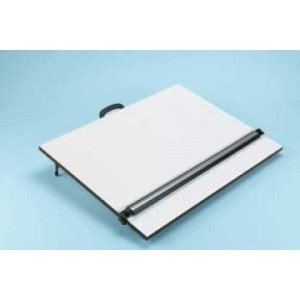Architects, cartoonists, contemporary artists and construction specialists rely on a drafting board to develop technical illustrations, construction sketches and commercial, contemporary and elegant artistic drawings. Absent a drafting board, items equipment and buildings like electronics, sky scrapers, log homes, shopping malls, household furniture and office complexes may not be designed and built.
If they were still designed and built, there might be fewer of them, as the boards have proven to be invaluable. Wikipedia shares that, “A drawing board (also drawing table, drafting table or architect’s table) is, in its antique form, a kind of multipurpose desk which can be used for any kind of drawing, writing or impromptu sketching on a large sheet of paper or for reading a large format book or other oversized document or for drafting precise technical illustrations.”
The drafting board grew in popularity during the Industrial Revolution. Today, there may not be many architects, artists and other people who create technical or artistic illustrations who would consider developing their works without using a drafting board. However, using the boards for long periods of time could put a strain on the human body.
To avoid short or long term physical discomfort, people who use drafting tables are encouraged to sit so their backs aren’t unduly arched. It’s also good to avoid slouching while working at the boards. Bodily strain can be reduced by adjusting or changing tables. According to Working Stiffs, “Drawing tables are versatile. There are a lot of different types of drafting tables. You can get portable drafting tables for those that don’t have a lot of extra space in their homes, or giant drawing boards with drafting machines built in for professional drafting firms.”
Artists should give themselves time to become familiar with drafting boards. It could take several weeks to learn how to work with the boards effectively. Regarding price, inexpensive drawing boards costs $100 or less. People who work with drawings and illustrations can get a quality drafting board from Plaza Art for less than $100.
Surface of boards can be kept clean by using board covers. Vyco is a popular board cover brand. Types of drawing boards on the market include Alvin lightweight parallel boards and Alvin parallel straightedge boards. Unfinished wood veneer surfaces and aluminum side edges are key features of some of these boards. Sizes of the boards range from 18 inches by 24 inches up to 24 inches by 26 inches.
Unless people plan on placing a drawing board on their lap as they work (which isn’t recommended, especially if artists and technicians work for extended periods), they are encouraged to place the board atop a drawing table. Additionally, work that requires an artist to use stretch paper and/or a T-bar is better developed on a drawing board that may or may not be placed atop a table.
As with other art equipment and supplies, it’s important to measure the results of the equipment and supplies. For example, artists can pay attention to how much definition their work has while using lightweight parallel boards versus straightedge boards.
James Baird









Speak Your Mind